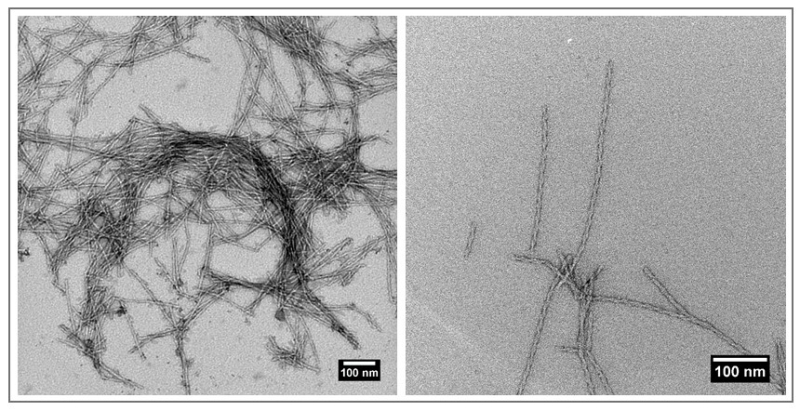LIPAGG, a European project to understand the formation of amyloid fibrils
Amyloid proteins, which cause widespread diseases such as Alzheimer's, Parkinson's and type 2 diabetes, still hold many secrets. The mechanism of amyloid induced cellular damage is at the heart of LIPAGG, a new collaborative project with support for 15 Doctoral Candidates funded by Horizon Europe.
With approximately 14 million people affected by Alzheimer's disease, 1.2 million by Parkinson's disease and 60 million by type 2 diabetes, these three diseases are particularly prevalent in Europe, with no curative treatments currently available. What they have in common is that they are caused by the propensity of specific proteins to aggregate and form oligomeric and fibrillar structures. This process is the focus of Lucie Khemtemourian’s research, CNRS research director at the Chemistry and Biology of Membranes and Nano-objects Laboratory (CBMN)1 , and the consortium of 23 partners from six EU countries she coordinates as part of a new Horizon Europe-funded project called LIPAGG2 .

Lipids at the heart of the investigation
“The proteins Aβ, α-synuclein and IAPP (islet amyloid polypeptide), which are respectively linked to Alzheimer's, Parkinson's disease and type 2 diabetes, are naturally present in the human body: in the brain for the first two and in the pancreas for the third,” explains the Bordeaux-based researcher. In monomeric form, they do not cause any problems. However, when they start to aggregate, disease occurs. Lucie Khemtemourian compares this aggregation mechanism to a well-known construction game: “Monomeric proteins are like individual Lego pieces. When they associate together, they form oligomers, which then aggregate into amyloid fibrils. At the interface of cell membranes, these aggregates induce cell death.” “While other researchers believe the protein is the sole cause of cell death, our project identifies a second factor contributing to the protein's toxicity: lipids.”, emphasizes Carmelo La Rosa, professor at the University of Catania and pioneer of the LipAgg hypothesis.
To better understand this mechanism, a first consortium was formed in 2020 with colleagues from Italy, France, Denmark and Germany. One hypothesis emerged: lipids, the primary component of cell membranes, play a crucial role in the formation of amyloid fibrils. “Lipids seem to serve as anchor points for monomers, thereby accelerating fibril formation,” notes Lucie Khemtemourian. “We do not yet know why, but this lipid-amyloid protein complex could potentially be more toxic than the proteins alone. That is what we are trying to understand.”

The quest for European funding
However, the path to European funding was fraught with obstacles. After the unsuccessful submission of a FET Open project in the Horizon 2020 framework, the predecessor to Horizon Europe, followed by an EIC Pathfinder project more focused on innovation, the consortium decided to expand their group to 9 Principal Investigators (adding a Swedish and a German team) and submit a Marie Skłodowska-Curie Actions (MSCA) Doctoral Networks, which supports the funding for excellence in training by research of 15 Ph.D. candidates.
A first application, in 2023, brought together nine academic teams from Italy, Germany, Denmark, Sweden and France, as well as eleven non-academic partners. “The strength of our consortium lies in the combination of research teams with complementary disciplinary expertise” explains Lucie Khemtemourian. “We are mainly uniting biophysicists, but also biologists to better understand what happens at the cellular level, and chemists, whose role is to synthesize molecules that inhibit the formation of amyloid fibrils.” The consortium includes academic departments equipped with cutting-edge techniques such as cryo-microscopy and nuclear magnetic resonance (NMR), as well as fluorescence, Fourier-transform infrared spectroscopy and molecular dynamics simulations at supercomputers.
This attempt failed in 2023 by such a slim margin that the consortium submitted again in 2024, this time with the help of European project engineer (IPE)1 Cécile Bacles. The implication of non-academic partners greatly strengthened the capacity for the LIPAGG Doctoral Candidates: it allows them to experience research beyond academia and its direct translation into cutting-edge innovation in biotechnology and pharmaceutics, as well as to gain a broad understanding of means of participation of patients in science. Ultimately, the LIPAGG project was accepted in 2024. “We are very happy to have made it this time,” says Lucie Khemtemourian. “This project is based on an interesting hypothesis, but also on a solid consortium, where everyone knows each other and there are no misunderstandings.” All these factors contributed to the success of the MSCA Doctoral Networks call. The LIPAGG project will begin in March 2026 and will be funded for four years with a budget of €4.6 million euros.
Editor: CD
- 1Local support offered by the CNRS to assist in setting up European projects
Now hiring
The consortium is looking for a European Project Manager to support the coordination of the LIPAGG Doctoral Network. For more information, visit the CNRS Job Portal. Apply by 3 November 2025.
